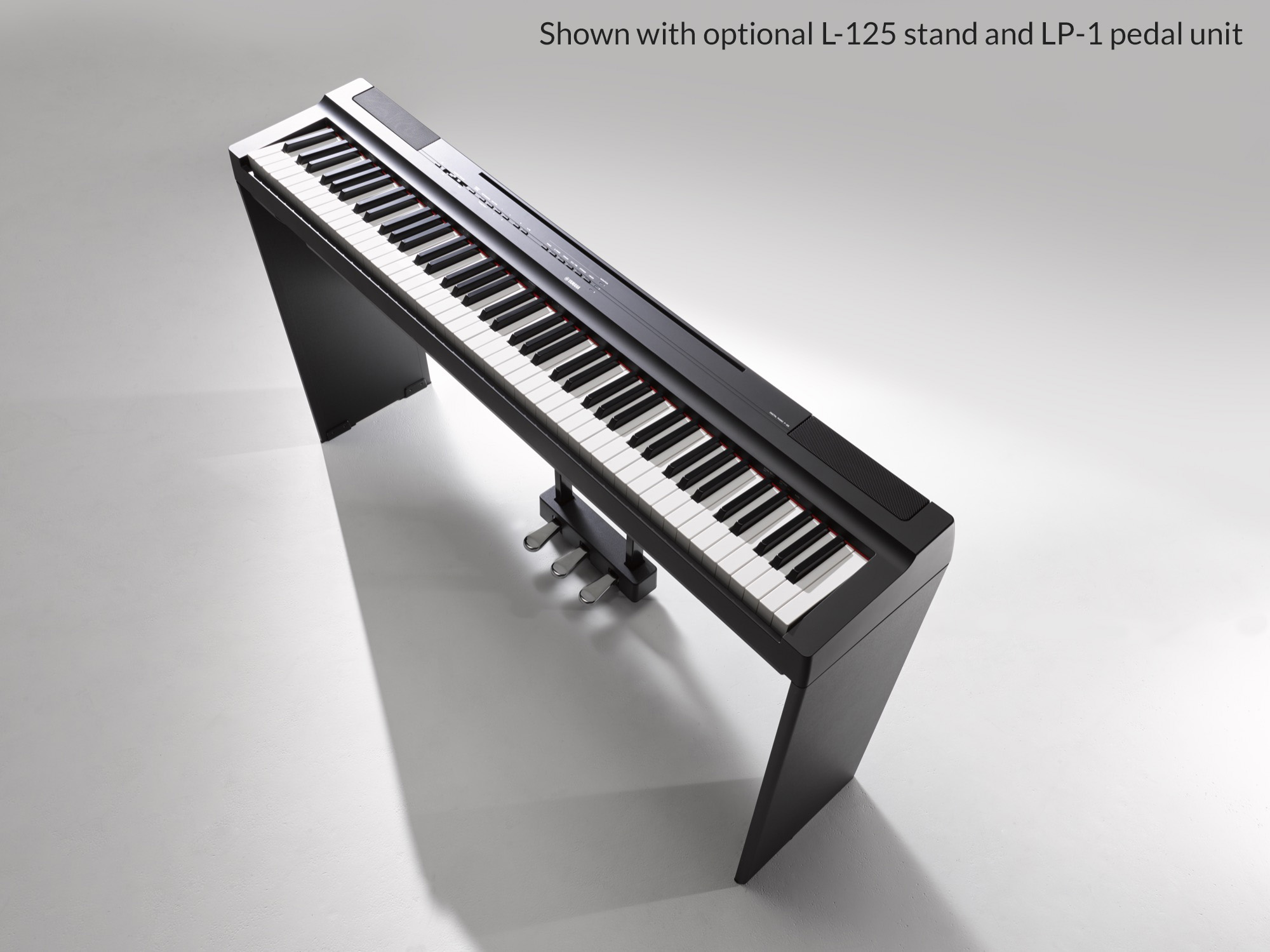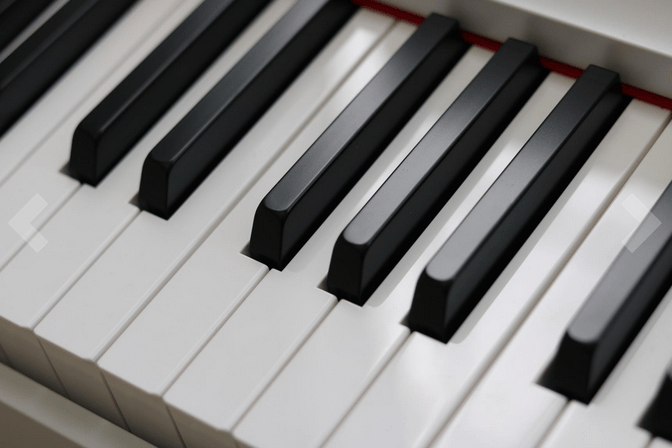Yamaha has really changed the way pianos have been used with the introduction of its portable sets. Apart from being lightweight and easy to carry, these pianos also carry a number of great features that add value to every single penny of money spent on them. We are here to discuss the specifications and features of the Yamaha P125 along with its pros and cons.
Table of Contents
Yamaha P125 Digital Piano Review
What’s Best in Yamaha P125?
- Compact, portable, and lightweight design
- 192 note polyphony that helps the player never go out of notes
- 24 high-quality sounds from different instruments
- The realistic tone of the CFIIIS grand
- Excellent sound quality and speakers
- Compatible with the smart pianist app
What’s Lacking in Yamaha P125?
- This piano doesn’t come with a triple pedal unit or a stand.
- The P-125 features traditional plastic keys that look shiny but lack texturing on its surface.
| Number of Keys | 88 |
| Piano Sound | Pure CF Sound Engine |
| Weight | 26 lbs |
| Keyboard Type | Graded Hammer Standard keyboard |
| USB to host connectivity | Yes |
| Polyphony | 192 |
The Overall Design of the Yamaha P125
This piano is a perfect mixture of both traditional elements and modern design details. It features an elegant curve at its front panel and has a felt ribbon accent, in red color running across its keys. This would surely impress the older adults as these features mimic the traditional piano designs, with a minimalistic look.

This piano is of the highest quality plastic and is available in white and black colors. It is portable, you can take it to consorts, for parties, and even to school and college competitions and stage shows. It weighs just 26 pounds and its dimensions are roughly 52 x 11.6 x 6.5 inches, good enough to get fit on a narrow classroom desk.
Even if you place it on an old piece of wood, it still sounds great, as it has a special setting known as Table EQ, this helps to optimize the sound when the unit has to be placed and played on a flat surface.
As we said earlier, its control panel is simple in contrast to a column of keys on other pianos. There are just 14 buttons on the front panel of the piano and there are LED indicators built under them so that you know exactly what function is being played at the moment.
There are special buttons for different sound sections such as the bass, E.piano, strings, organ, piano, etc., and there are special buttons for rhythms, recording, metronome features, etc. The volume slider helps in increasing or decreasing the volume of the piano gradually. As there are limited automated options available, this keyboard is an ideal unit for those who wish to develop their inherent keyboard skills.
Most of the time, the pianist has to use the button + key combination to tune their songs and the P125 is compatible with the smart pianist app from Yamaha, which helps people to control the functions of the instrument with the help of a graphic interface.
Related Reading:- List of Best Yamaha Digital Pianos 2023
How Its Keys Feel Like

The pianist who creates the best music out of the keys in the instrument is aware of the placement of the keys and they know exactly which key to strike for a specific chord. It is highly important that their hands don’t flip off and touch the neighboring key instead.
The Keys of the Yamaha P125 feature a matte finish, which makes them the best piano for high humid situations. The pianist is able to have an authentic performance as their fingers are less likely to slip off the keys.
The keys of the piano follow the hammer standard action as that of acoustic pianos of ancient times. We can claim that the sound emitted from this 88-keyed piano renders a more natural feel and is definitely a great value for the money spent.
The keyboard is sensitive to touch, they feel heavier at the lower registers (at the proximal end) and lighter at the higher registers (distal end), just like the acoustic piano. The keys can alter the volume and timbre of the sound, depending on how hard or soft, you play its keys.
Beginners and those who are learning to play the piano should resort to medium touch sensitivity. As they get proficient, they can choose between the four touch settings – soft, medium, hard, and fixed. Remember that when you select the fixed setting, the piano resonates with the same volume of sound, irrespective of the force on the keys.
Check out: Yamaha YDP-184 Arius Series Flagship Digital Piano Review
Different Modes of Playing
There are totally four modes to choose from when you buy the P125 piano. Apart from the whole keyboard mode, the three additional modes are the dual-mode, split mode and
If you want to create the sounds of two different musical instruments for your stage show, then you can choose the dual mode. In this mode, when you press a key, two sounds of two different instruments, for example, the guitar and piano play together.
By resorting to the split mode, you actually divide the keyboard into two halves on the left side you play the guitar and on the right, you play the piano. There is no layering of music tones here as that of dual-mode.
The Duo mode or the twin mode or partner mode splits the board into two equal parts and helps in duet play. It creates a feeling that the entire piano is divided into two 44 keys pianos. This function is meant for teachers, who can make two students play the same note at one time from the same piano.
How the Piano Sounds
Here comes the most important feature of the P125 piano. Every time you strike the keys, you listen to the high-quality pure CF sound engine of the CFIIIS concert grand. Each of the sounds is recorded at different velocity levels to recreate the sound range and richness of the acoustic piano.
This piano also incorporates organic elements such as string resonance, key-off simulation, etc to enrich the sound quality and to make it sound more natural. You will love the depth, realism, and richness of the sounds this piano creates. The Yamaha P125 has 24 built-in tones (six sounds with 4 tone variations each).
Polyphony or the number of notes this piano could produce at the same time is about 192 notes. Thus, you could never run out of notes with this piano. Other pianos at this price point struggle to create 128 notes.
Check out this complete demo of Yamaha P125 on YouTube.
Sound Amplification System
The P-125 features a newly redesigned speaker system. It has four speakers, two on either side. Two of them are 12 cm, full-range speakers, whereas the other two are 4 cm tweeters. All four ensure crystal clear sound quality even at higher frequencies.
The speakers are capable of creating 14 W power, good enough to fill a small size auditorium with great sound amplification. Apart from the table EQ feature, this piano has a sound boost feature, which helps in getting the chords sharper and louder.
The intelligent acoustic control, the proprietary technology of Yamaha helps in adjusting the frequency response for better and clear audibility of both the high and low register notes.
Teaching Mode
The P125 has a library of 50 preset piano chords of famous composers. You can listen to these songs and use them to practice as well. You can divide the keyboard into half, while the first half plays back, you can play the song live on the other.
For listening and evaluating your own performance, you can take advantage of its recording and playback feature. You have to record the chords in MIDI format and transfer the same to the PC. You can also play two independent tracks and play them together as a single song. You can also import songs from the computer in MIDI format and store them on this piano to learn the song and practice it.
Yamaha P125 Connectivity Features
The Yamaha P125 features two headphone jacks, a USB jack to host port, sustain pedal jack, and Aux jacks. The headphone jack is at the front left side of the piano which helps to plug two pairs of headphones at a time.
The Aux out connects the piano with external audio equipment like an amplifier, mixer, PA system, etc. The USB to host jack connects the piano with a computer to exchange MIDI data and songs.

Accessories
The piano does not come with a stand but comes with a music rest feature. Other accessories with the piano are the sustain pedal or footswitch, AC power adaptor, and owner’s manual.
Alternatives of Yamaha P125
In a nutshell
We can summarize that the Yamaha P125 is one of the best in the entire range of digital pianos from Yamaha (Yamaha YDP-103, YDP-144, YDP-164, etc..). Apart from being compact and user-friendly it also poses an elegant design that you will resist taking your fingers off it. It does not have a complex console and looks simple and neat in its exteriors, but surpasses its precursors with regard to its features.
Related:-


Thank You for the amazing Yamaha P125 piano review. I was so confused about whether to buy it or not. But now I have already ordered this digital piano from Yamaha as I always wanted a lightweight piano with most acoustic sound. And this decision has come after days of research. I also looked into other lightweight models of Yamaha, but P125 seems to be the best option available at this price.